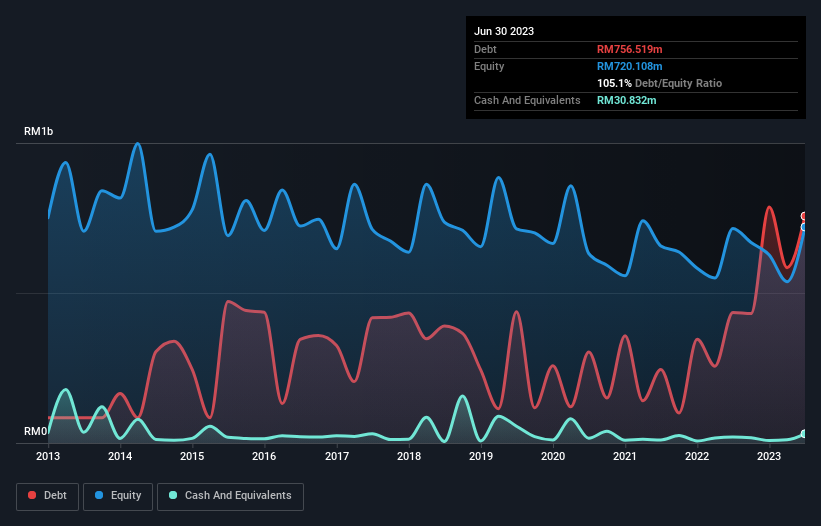Nestlé (Malaysia) Berhad (KLSE:NESTLE) Has A Pretty Healthy Balance Sheet

Legendary fund manager Li Lu (who Charlie Munger backed) once said, 'The biggest investment risk is not the volatility of prices, but whether you will suffer a permanent loss of capital.' So it might be obvious that you need to consider debt, when you think about how risky any given stock is, because too much debt can sink a company. We note that Nestlé (Malaysia) Berhad (KLSE:NESTLE) does have debt on its balance sheet. But should shareholders be worried about its use of debt?
When Is Debt A Problem?
Debt assists a business until the business has trouble paying it off, either with new capital or with free cash flow. If things get really bad, the lenders can take control of the business. While that is not too common, we often do see indebted companies permanently diluting shareholders because lenders force them to raise capital at a distressed price. Of course, debt can be an important tool in businesses, particularly capital heavy businesses. The first step when considering a company's debt levels is to consider its cash and debt together.
See our latest analysis for Nestlé (Malaysia) Berhad
How Much Debt Does Nestlé (Malaysia) Berhad Carry?
You can click the graphic below for the historical numbers, but it shows that as of June 2023 Nestlé (Malaysia) Berhad had RM756.5m of debt, an increase on RM435.0m, over one year. However, because it has a cash reserve of RM30.8m, its net debt is less, at about RM725.7m.

A Look At Nestlé (Malaysia) Berhad's Liabilities
The latest balance sheet data shows that Nestlé (Malaysia) Berhad had liabilities of RM2.19b due within a year, and liabilities of RM658.4m falling due after that. On the other hand, it had cash of RM30.8m and RM543.2m worth of receivables due within a year. So its liabilities outweigh the sum of its cash and (near-term) receivables by RM2.28b.
Given Nestlé (Malaysia) Berhad has a market capitalization of RM29.8b, it's hard to believe these liabilities pose much threat. Having said that, it's clear that we should continue to monitor its balance sheet, lest it change for the worse.
We measure a company's debt load relative to its earnings power by looking at its net debt divided by its earnings before interest, tax, depreciation, and amortization (EBITDA) and by calculating how easily its earnings before interest and tax (EBIT) cover its interest expense (interest cover). This way, we consider both the absolute quantum of the debt, as well as the interest rates paid on it.
Nestlé (Malaysia) Berhad's net debt is only 0.69 times its EBITDA. And its EBIT easily covers its interest expense, being 37.1 times the size. So you could argue it is no more threatened by its debt than an elephant is by a mouse. But the other side of the story is that Nestlé (Malaysia) Berhad saw its EBIT decline by 3.3% over the last year. That sort of decline, if sustained, will obviously make debt harder to handle. When analysing debt levels, the balance sheet is the obvious place to start. But it is future earnings, more than anything, that will determine Nestlé (Malaysia) Berhad's ability to maintain a healthy balance sheet going forward. So if you're focused on the future you can check out this free report showing analyst profit forecasts.
Finally, a business needs free cash flow to pay off debt; accounting profits just don't cut it. So we always check how much of that EBIT is translated into free cash flow. During the last three years, Nestlé (Malaysia) Berhad produced sturdy free cash flow equating to 64% of its EBIT, about what we'd expect. This free cash flow puts the company in a good position to pay down debt, when appropriate.
Our View
The good news is that Nestlé (Malaysia) Berhad's demonstrated ability to cover its interest expense with its EBIT delights us like a fluffy puppy does a toddler. But, on a more sombre note, we are a little concerned by its EBIT growth rate. Taking all this data into account, it seems to us that Nestlé (Malaysia) Berhad takes a pretty sensible approach to debt. That means they are taking on a bit more risk, in the hope of boosting shareholder returns. When analysing debt levels, the balance sheet is the obvious place to start. However, not all investment risk resides within the balance sheet - far from it. We've identified 2 warning signs with Nestlé (Malaysia) Berhad (at least 1 which doesn't sit too well with us) , and understanding them should be part of your investment process.
Of course, if you're the type of investor who prefers buying stocks without the burden of debt, then don't hesitate to discover our exclusive list of net cash growth stocks, today.
Valuation is complex, but we're here to simplify it.
Discover if Nestlé (Malaysia) Berhad might be undervalued or overvalued with our detailed analysis, featuring fair value estimates, potential risks, dividends, insider trades, and its financial condition.
Access Free AnalysisHave feedback on this article? Concerned about the content? Get in touch with us directly. Alternatively, email editorial-team (at) simplywallst.com.
This article by Simply Wall St is general in nature. We provide commentary based on historical data and analyst forecasts only using an unbiased methodology and our articles are not intended to be financial advice. It does not constitute a recommendation to buy or sell any stock, and does not take account of your objectives, or your financial situation. We aim to bring you long-term focused analysis driven by fundamental data. Note that our analysis may not factor in the latest price-sensitive company announcements or qualitative material. Simply Wall St has no position in any stocks mentioned.
About KLSE:NESTLE
Nestlé (Malaysia) Berhad
Manufactures and sells food and beverage products in Malaysia and internationally.
Moderate growth potential with mediocre balance sheet.
Market Insights
Community Narratives



